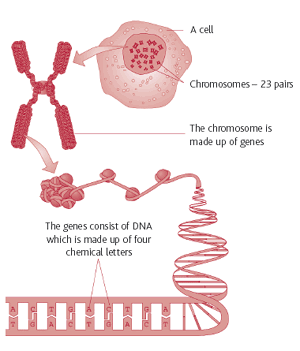What is Gene Therapy?
Table of Contents
What is a gene and how does it work?
The nucleus is found in the middle part of each of your cells. The nucleus has your DNA (deoxyribose nucleic acid) in it. Your DNA is the genetic code that was passed down (inherited) from each of your parents. Each person has between 20,000 and 25,000 genes in their body. You have 46 chromosomes, which are each made up of thousands of genes. You have 2 copies of every gene, 1 inherited from each of your parents.
Genes have the instructions for cells to make proteins. Your body needs these proteins for most life functions. Genes tell cells how to work, control our growth and development, and determine what we look like and how our bodies work. They also play a role in the repair of damaged cells and tissues.
What is gene therapy?
If a gene becomes damaged, this damage is called a mutation. Mutations can cause the gene to not work how it should and cells can grow out of control. When cells grow too quickly or uncontrollably, cancer forms. Things like smoking or the environment may cause these mutations, or they may be inherited. If we could fix these mutations, we could stop cancer from starting.
Researchers are testing ways to use gene therapy to treat cancer. Gene therapy may be used to:
- Replace missing or non-working genes. For example, p53 is a gene called a "tumor suppressor gene." Tumor suppressor genes prevent or stop tumors from forming. Cells that are missing this gene or have a non-working copy because of a mutation, may be "fixed" by adding working copies of p53 to the cell.
- Stop certain genes that can cause new cancer or the spread of an existing cancer (called “metastasis”). These genes are called “Oncogenes.” By stopping these genes, the cancer and/or its spread may be stopped.
- Use the body's own immune system by putting genes into cancer cells that trigger the body to attack the cancer cells as foreign invaders.
- Put genes into cancer cells so that chemotherapy, radiation therapy, or hormone therapies can attack the cancer cells more easily.
- Create "suicide genes" that can enter cancer cells and cause them to die off.
- Prevent new blood vessels from growing within the tumor. Cancers need a blood supply to grow and survive. By stopping the blood supply, the cancer slows or stops growing (called “anti-angiogenesis”).
- Use genes to protect healthy cells from the side effects of therapy, allowing higher doses of chemotherapy and radiation to be given.
How is gene therapy given?
It is not easy getting the genes into the tiny cells. For this reason, a carrier (called a “vector”) is used. The most common vectors are viruses. The genes of the virus vector must be changed to carry human DNA. These viruses are like those that cause the common cold, only they are "deactivated" (turned off) so that they will not cause the patient to get the cold.
In some cases, cells are taken from the patient and mixed with the virus in a lab. The virus with the desired gene finds its way into the cells. These cells grow in the lab. The grown cells are then given back to the patient by intravenous (IV) infusion into a vein or are injected into a body part (such as the lung) or the tumor.
In other cases, the vector with the attached gene is first inserted into the patient by intravenous infusion into a vein or injected into a body part or tumor. Once the gene has reached the cell, it must go to the nucleus of the cell (where the DNA is) and mix in with the human genetic material. The gene then needs to be "turned on" to produce the protein of that gene. For gene delivery to work, the protein that is made must work properly.
What are the side effects of gene therapy?
Gene therapy is a newer treatment option for cancer. At this time, we do not know all the side effects it may have, especially long-term side effects that may happen years after receiving this therapy. After receiving gene therapy, the patient's immune system may react to the foreign vector. Symptoms of a reaction may be a fever, severe chills (called rigors), a drop in blood pressure, nausea, vomiting, and headache. These symptoms often get better within 24 to 48 hours of receiving the treatment. Other side effects depend on the type of vector used and how it is given. For example, if the gene is given into a patient's lung, the side effects may affect the lung.
Some side effects are “theoretical,” meaning that it is possible that they could happen, but they have not actually happened in clinical trials yet. There is a fear that the genes could enter healthy cells and damage them, which could lead to another disease or another cancer. If genes enter reproductive cells, they could damage sperm or eggs. It is feared that this damage could then be passed on to future generations. At this time, researchers are very careful to watch for these unwanted side effects and perform tests in animal studies before the therapy is given to humans.
Talk with your care team about whether gene therapy is part of your treatment plan and if there any specific side effects that you should be aware of.
Resource for more information
American Society of Gene & Cell Therapy. Cancer Gene Therapy and Cell Therapy. Found at: https://www.asgct.org/education/gene-and-cell-therapy-defined
National Institute of Health. Genetics Home Reference. What is Gene Therapy? Found at: https://ghr.nlm.nih.gov/primer/therapy/genetherapy
